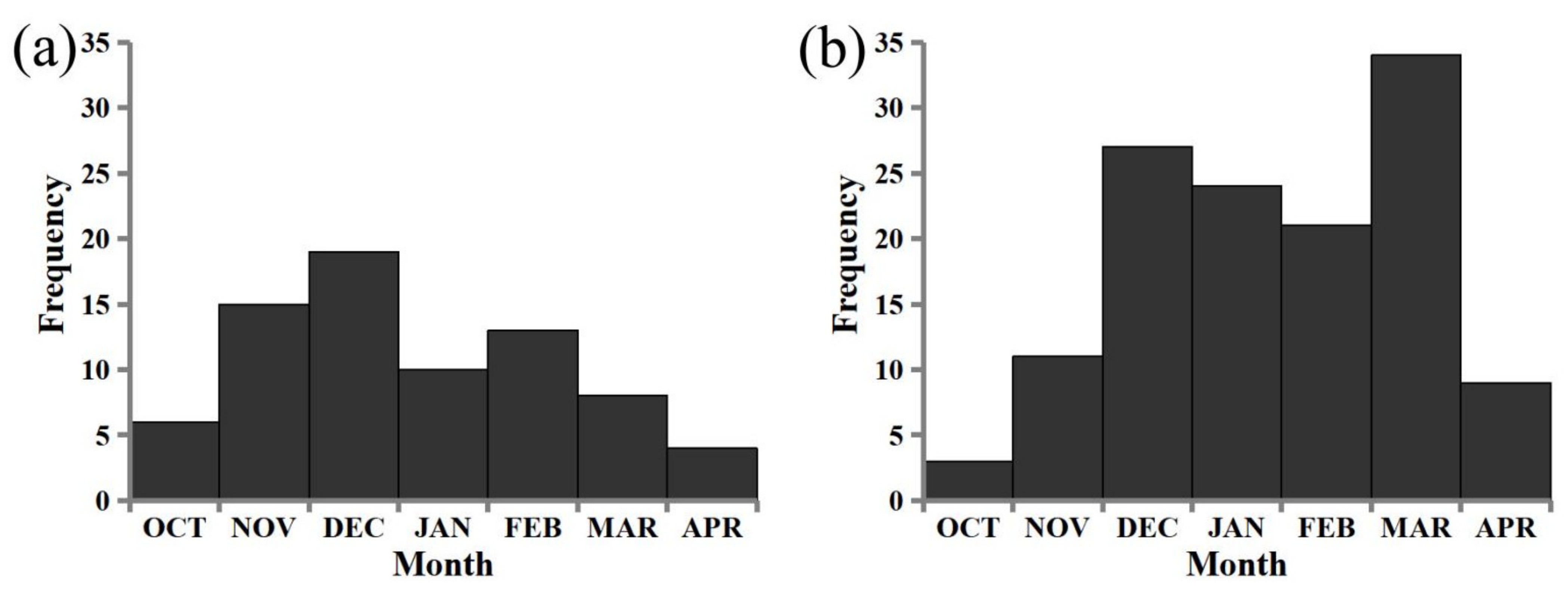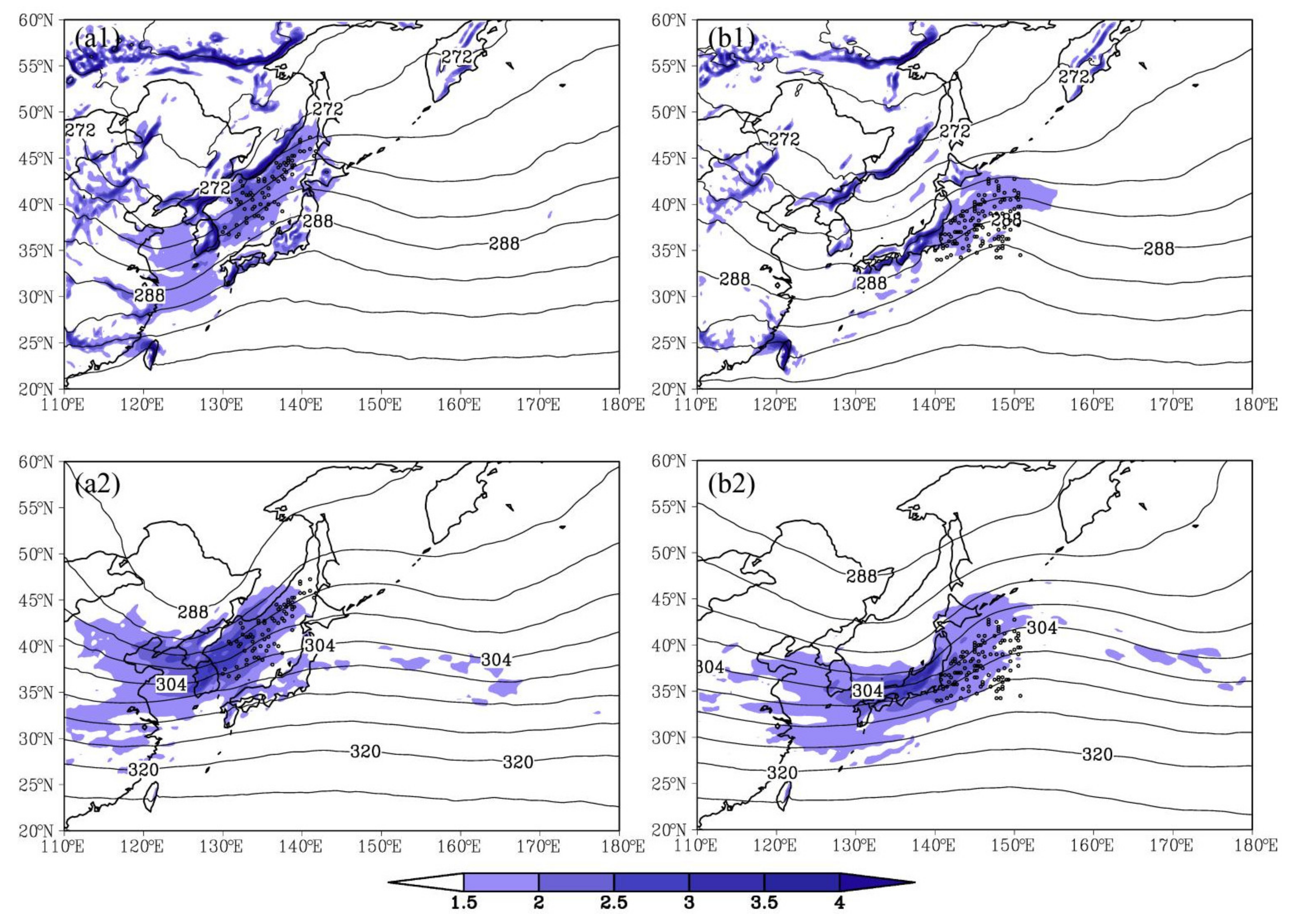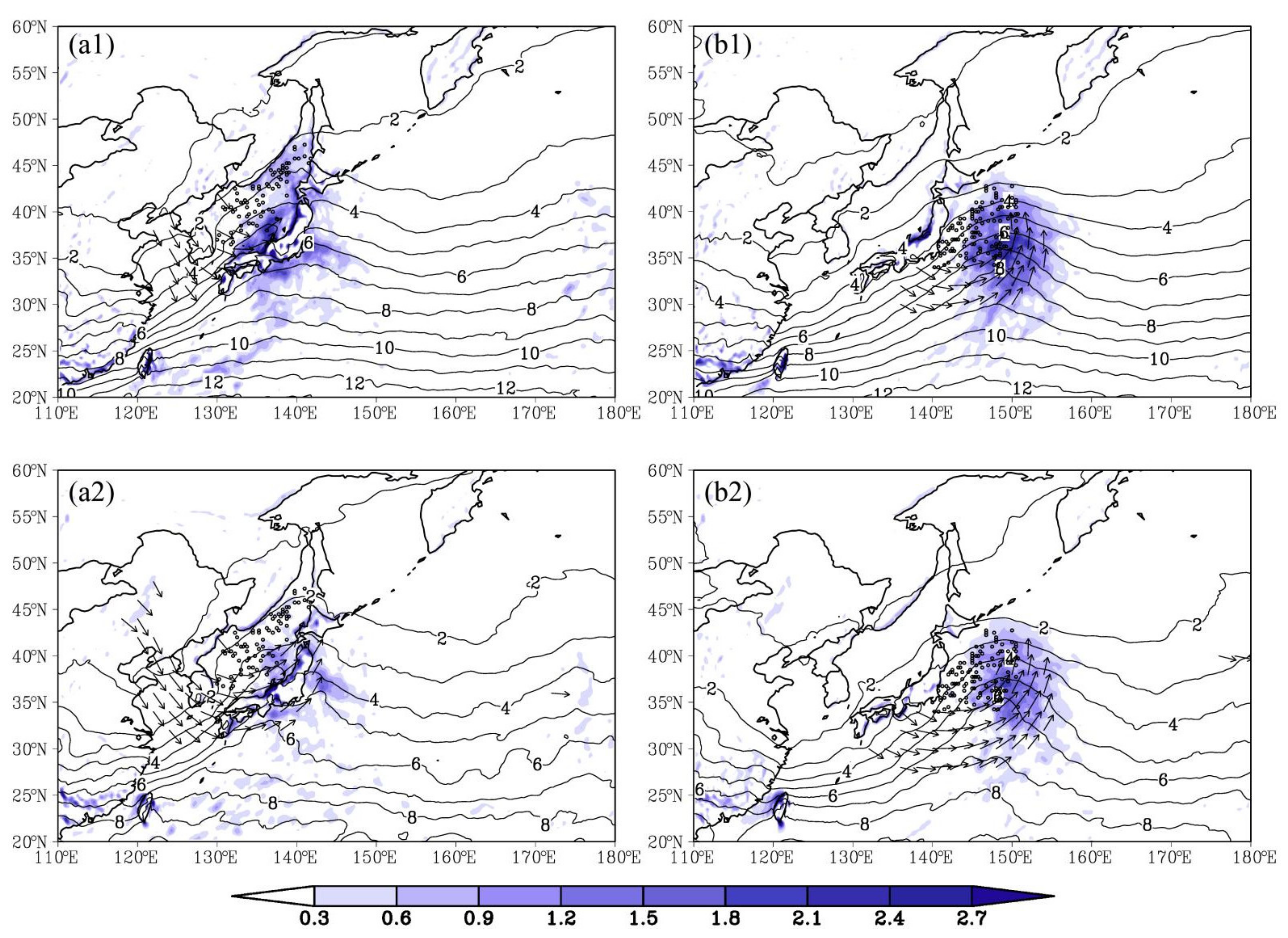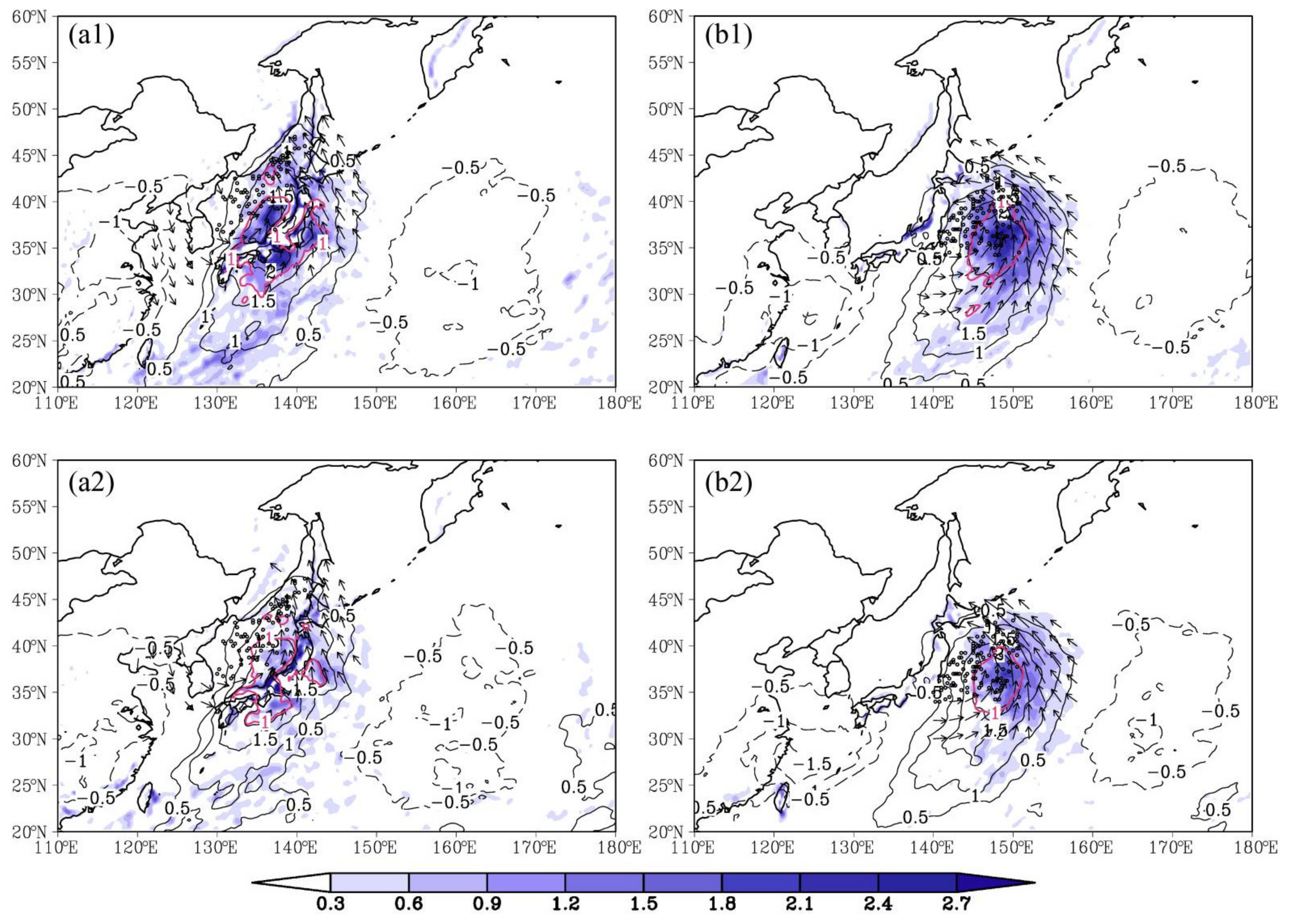Statistical Characteristics and Composite Environmental Conditions of Explosive Cyclones over the Japan Sea and Kuroshio/Kuroshio Extension
Abstract
:1. Introduction
2. Data and Methods
2.1. Data
2.2. Methods
2.2.1. Definition of EC
2.2.2. Relative Vorticity and PV Calculation
2.2.3. Identification of ECs
- (1)
- Cyclone detection
- (2)
- Cyclone tracking
- (3)
- EC identification
2.2.4. Composite Analysis
3. Results
3.1. Statistical Characteristics
3.1.1. Monthly Frequency
3.1.2. Frequency of MDR
3.1.3. Frequency of Minimum Central SLP
3.1.4. Frequency of Explosive-Developing Lifetime
3.1.5. Moving Track
3.2. Composite Synoptic-Scale Environmental Conditions
3.2.1. Low-Level Baroclinicity
3.2.2. Low-Level Water Vapor
3.2.3. Mid-Upper Level Cyclonic Vorticity
3.2.4. Upper-Level Jet Stream and Potential Vorticity
4. Discussion and Conclusions
Author Contributions
Funding
Data Availability Statement
Acknowledgments
Conflicts of Interest
References
- Sanders, F.; Gyakum, J.R. Synoptic-dynamic climatology of the “Bomb”. Mon. Weather Rev. 1980, 108, 1589–1606. [Google Scholar] [CrossRef] [Green Version]
- Zhang, S.; Fu, G.; Lu, C.; Liu, J. Characteristics of explosive cyclones over the Northern Pacific. J. Appl. Meteor. Clim. 2017, 56, 3187–3210. [Google Scholar] [CrossRef]
- Katsafados, P.; Mavromatidis, E.; Papadopoulos, A.; Pytharoulis, I. Numerical simulation of a deep Mediterranean storm and its sensitivity on sea surface temperature. Nat. Hazards Earth Syst. Sci. 2011, 11, 1233–1246. [Google Scholar] [CrossRef]
- Fink, A.; Pohle, S.; Pinto, J.G.; Knippertz, P. Diagnosing the influence of diabatic process on the explosive deepening of extratropical cyclones. Atmos. Sci. Lett. 2012, 39, 7. [Google Scholar] [CrossRef] [Green Version]
- Liberato, M.L.R. The 19 January 2013 windstorm over the North Atlantic: Large scale dynamics and impacts on Iberia. Weather Clim. Extrem. 2014, 5, 16–28. [Google Scholar] [CrossRef] [Green Version]
- Roebber, P.J. Statistical analysis and updated climatology of explosive cyclones. Mon. Weather Rev. 1984, 112, 1577–1589. [Google Scholar] [CrossRef]
- Gyakum, J.R.; Anderson, R.; Grumm, H.; Gruner, E.L. North Pacific cold-season surface cyclone activity: 1975–1983. Mon. Weather Rev. 1989, 117, 1141–1155. [Google Scholar] [CrossRef] [Green Version]
- Yoshida, A.; Asuma, Y. Structures and environment of explosively developing extratropical cyclones in the northwestern Pacific region. Mon. Weather Rev. 2004, 132, 1121–1142. [Google Scholar] [CrossRef]
- Seiler, C.; Zwiers, F.W. How well do CMIP5 climate models reproduce explosive cyclones in the extratropics of the Northern Hemisphere? Clim. Dyn. 2016, 46, 1241–1256. [Google Scholar] [CrossRef]
- Seiler, C.; Zwiers, F.W. How will climate change affect explosive cyclones in the extratropics of the Northern Hemisphere? Clim. Dyn. 2016, 46, 3633–3644. [Google Scholar] [CrossRef]
- Fu, G.; Sun, Y.W.; Sun, J.L.; Li, P.Y. A 38-year climatology of explosive cyclones over the Northern Hemisphere. Adv. Atmos. Sci. 2020, 37, 143–159. [Google Scholar] [CrossRef]
- Iwao, K.; Inatsu, M.; Kimoto, M. Recent changes in explosively developing extratropical cyclones over the winter Northwestern Pacific. J. Climat. 2012, 25, 7282–7296. [Google Scholar] [CrossRef]
- Chen, S.J.; Kuo, Y.H.; Zhang, P.Z.; Bai, Q.F. Climatology of explosive cyclones off the East Asian coast. Mon. Weather Rev. 1992, 120, 3029–3035. [Google Scholar] [CrossRef]
- Kuwano-Yoshida, A.; Asuma, Y. Numerical study of explosively developing extratropical cyclones in the Northwestern Pacific region. Mon. Weather Rev. 2008, 136, 712–740. [Google Scholar] [CrossRef]
- Chen, T.C.; Chang, C.B.; Perkey, D.J. Numerical study of an AMTEX ’75 oceanic cyclone. Mon. Weather Rev. 1983, 111, 1818–1829. [Google Scholar] [CrossRef] [Green Version]
- Chen, T.C.; Chang, C.B.; Perkey, D.J. Synoptic study of a medium-scale oceanic cyclone during AMTEX ’75. Mon. Weather Rev. 1985, 113, 349–361. [Google Scholar] [CrossRef] [Green Version]
- Yoshiike, S.; Kawamura, R. Inflfluence of wintertime largescale circulation on the explosively developing cyclones over the western North Pacifific and their downstream effects. J. Geophys. Res. 2009, 114, D13110. [Google Scholar] [CrossRef] [Green Version]
- Iizuka, S.; Shiota, M.; Kawamura, R.; Hatsushika, H. Influence of the monsoon variability and sea surface temperature front on the explosive cyclone activity in the vicinity of Japan during northern winter. SOLA 2013, 9, 1–4. [Google Scholar] [CrossRef] [Green Version]
- Hotta, D.; Nakamura, H. On the significance of sensible heat supply from the ocean in the maintenance of mean baroclinicity along storm tracks. J. Clim. 2011, 24, 3377–3401. [Google Scholar] [CrossRef]
- Sanders, F.; Davis, C.A. Patterns of thickness anomaly for explosive cyclogenesis over the West-Central North Atlantic Ocean. Mon. Weather Rev. 1988, 116, 2725–2730. [Google Scholar] [CrossRef] [Green Version]
- Wang, C.C.; Rogers, J.C. A composite study of explosive cyclogenesis in different sectors of the North Atlantic. Part I: Cyclone structure and evolution. Mon. Weather Rev. 2001, 129, 1481–1499. [Google Scholar] [CrossRef]
- Heo, K.Y.; Seo, Y.W.; Ha, K.J.; Park, K.S.; Kim, J.; Choi, J.W.; Jun, K.; Jeong, J.K. Development mechanisms of an explosive cyclone over East Sea on 3–4 April 2012. Dyn. Atmos. Oceans 2015, 70, 30–46. [Google Scholar] [CrossRef]
- Mullen, S.L.; Baumhefner, D.P. Sensitivity of numerical simulations of explosive oceanic cyclogenesis to changes in physical parameterizations. Mon. Weather Rev. 1988, 116, 2289–2329. [Google Scholar] [CrossRef] [Green Version]
- Hirata, H.; Kawamura, R. Influential role of moisture supply from the Kuroshio/Kuroshio Extension in the rapid development of an extratropical cyclone. Mon. Weather Rev. 2015, 143, 4126–4144. [Google Scholar] [CrossRef]
- Hirata, H.; Kawamura, R.; Kato, M.; Shinoda, T. Response of rapidly developing extratropical cyclones to sea surface temperature variations over the western Kuroshio–Oyashio confluence region. J. Geophys. Res. Atmos. 2016, 121, 3843–3858. [Google Scholar] [CrossRef] [Green Version]
- Hirata, H.; Kawamura, R.; Kato, M.; Shinoda, T. A positive feedback process related to the rapid development of an extratropical cyclone over the Kuroshio/Kuroshio Extension. Mon. Weather Rev. 2018, 146, 417–433. [Google Scholar] [CrossRef]
- Yokoyama, Y.; Yamamoto, M. Influences of surface heat flux on twin cyclone structure during their explosive development over the East Asian marginal seas on 23 January. Weather Clim. Extrem. 2019, 23, 100198. [Google Scholar] [CrossRef]
- Lupo, A.R.; Smith, P.J.; Zwack, P. A diagnosis of the explosive development of two extratropical cyclones. Mon. Weather Rev. 1992, 120, 1490–1523. [Google Scholar] [CrossRef] [Green Version]
- Azad, R.; Sorteberg, A. The vorticity budgets of North Atlantic winter extratropical cyclone life cycles in MERRA reanalysis. Part I: Development phase. J. Atmos. Sci. 2014, 71, 3109–3128. [Google Scholar] [CrossRef]
- Wang, S.; Fu, G.; Pang, H. Structure analyses of the explosive extratropical cyclone: A case study over the Northwestern Pacific in March 2007. J. Ocean Univ. China 2017, 16, 933–944. [Google Scholar] [CrossRef] [Green Version]
- Hoskins, B.J.; McIntyre, M.E.; Bobertson, A.W. On the use and significance of isentropic potential vorticity maps. Q. J. R. Meteorol. Soc. 1985, 111, 877–946. [Google Scholar] [CrossRef]
- Davis, C.A.; Emanuel, K.A. Potential vorticity diagnostics of cyclogenesis. Mon. Weather Rev. 1991, 119, 1929–1953. [Google Scholar] [CrossRef] [Green Version]
- Davis, C.A.; Stoelinga, M.T.; Kuo, Y.-H. The integrated effect of condensation in numerical simulations of extratropical cyclogenesis. Mon. Weather Rev. 1993, 121, 2309–2330. [Google Scholar] [CrossRef] [Green Version]
- Wash, C.H.; Peak, J.E.; Calland, W.E.; Cook, W.A. Diagnostic study of explosive cyclogenesis during FGGE. Mon. Weather Rev. 1988, 116, 431–451. [Google Scholar] [CrossRef] [Green Version]
- Chen, S.J.; Dellosso, L. A numerical case study of east Asia coastal cyclogenesis. Mon. Weather Rev. 1987, 115, 477–487. [Google Scholar] [CrossRef] [Green Version]
- Hersbach, H.; Bell, B.; Berrisford, P.; Hirahara, S.; Horányi, A.; Muñoz-Sabater, J.; Nicolas, J.; Peubey, C.; Radu, R.; Schepers, D.; et al. The ERA5 global reanalysis. Q. J. R. Meteorol. Soc. 2020, 146, 1999–2049. [Google Scholar] [CrossRef]
- Hart, R.E. A cyclone phase space derived from thermal wind and thermal asymmetry. Mon. Weather Rev. 2003, 131, 585–616. [Google Scholar] [CrossRef]
- Bosart, L.F.; Lin, S.C. A diagnostic analysis of the Presidents’ Day storm of February 1979. Mon. Weather Rev. 1984, 112, 2148–2177. [Google Scholar] [CrossRef] [Green Version]
- Rogers, E.; Bosart, L.F. An investigation of explosively deepening oceanic cyclones. Mon. Weather Rev. 1986, 114, 702–718. [Google Scholar] [CrossRef]
- Zhang, S.; Liu, C.; Xu, J.; Zhang, S.; Tang, R.; Huang, Z.; Zheng, Y.; Guan, Z.; Mao, H.; Xue, Y. Physical process contributions to the development of a super explosive cyclone over the Gulf Stream. Front. Earth Sci. 2021, 9, 722555. [Google Scholar] [CrossRef]
- Sanders, F. Explosive cyclogenesis in the west-central North Atlantic Ocean, 1981–1984. Part I: Composite structure and mean behavior. Mon. Weather Rev. 1986, 114, 1781–1794. [Google Scholar] [CrossRef]
- Manobianco, J. Explosive east coast cyclogenesis over the west-central North Atlantic Ocean: A composite study derived from ECMWF operational analyses. Mon. Weather Rev. 1989, 117, 2365–2383. [Google Scholar] [CrossRef] [Green Version]
- Kuwano-Yoshida, A.; Enomoto, T. Predictability of explosive cyclogenesis over the Northwestern Pacific region using ensemble reanalysis. Mon. Weather Rev. 2013, 141, 3769–3785. [Google Scholar] [CrossRef] [Green Version]
- Nuss, W.A.; Kamikawa, S.I. Dynamics and boundary layer processes in two Asian cyclones. Mon. Weather Rev. 1990, 118, 755–771. [Google Scholar] [CrossRef] [Green Version]
- Yamamoto, M. Migration of contact binary cyclones and atmospheric river: Case of explosive extratropical cyclones in East Asia on 16 December 2014. Dyn. Atmos. Ocean. 2018, 83, 17–40. [Google Scholar] [CrossRef]
- Neiman, P.J.; Shapiro, M.A. The life cycle of an extratropical marine cyclone. Part I: Frontal-cyclone evolution and thermodynamic air–sea interaction. Mon. Weather Rev. 1993, 121, 2153–2176. [Google Scholar] [CrossRef]
- Uccellini, L.W.; Kocin, P.J. The interaction of jet streak circulations during heavy snow events along the east coast of United States. Weather Forecast. 1987, 2, 289–308. [Google Scholar] [CrossRef] [Green Version]
- Cammas, J.P.; Ramond, D. Analysis and diagnosis of the composite of ageostrophic circulations in jet-front systems. Mon. Weather Rev. 1989, 117, 2447–2462. [Google Scholar] [CrossRef] [Green Version]
- Nakamura, H. Horizontal divergence associated with zonally isolated jet steams. J. Atmos. Sci. 1993, 50, 2310–2313. [Google Scholar] [CrossRef] [Green Version]
- Keyser, D.; Shapiro, M.A. A review of the structure and dynamics of upper-level frontal zones. Mon. Weather Rev. 1986, 114, 452–499. [Google Scholar] [CrossRef]
- Zhang, S.; Fu, G. Structures and evolutions of explosive cyclones over the Northwestern and Northeastern Pacific. J. Ocean Univ. China 2018, 17, 581–593. [Google Scholar] [CrossRef]













Publisher’s Note: MDPI stays neutral with regard to jurisdictional claims in published maps and institutional affiliations. |
© 2021 by the authors. Licensee MDPI, Basel, Switzerland. This article is an open access article distributed under the terms and conditions of the Creative Commons Attribution (CC BY) license (https://creativecommons.org/licenses/by/4.0/).
Share and Cite
Zhang, S.; Fu, G.; Zhang, Y.; Xu, J.; Xue, Y.; Tang, R.; Gao, X.; Liu, C.; Long, J. Statistical Characteristics and Composite Environmental Conditions of Explosive Cyclones over the Japan Sea and Kuroshio/Kuroshio Extension. Atmosphere 2022, 13, 17. https://doi.org/10.3390/atmos13010017
Zhang S, Fu G, Zhang Y, Xu J, Xue Y, Tang R, Gao X, Liu C, Long J. Statistical Characteristics and Composite Environmental Conditions of Explosive Cyclones over the Japan Sea and Kuroshio/Kuroshio Extension. Atmosphere. 2022; 13(1):17. https://doi.org/10.3390/atmos13010017
Chicago/Turabian StyleZhang, Shuqin, Gang Fu, Yu Zhang, Jianjun Xu, Yufeng Xue, Ruoying Tang, Xiaoyu Gao, Chunlei Liu, and Jingchao Long. 2022. "Statistical Characteristics and Composite Environmental Conditions of Explosive Cyclones over the Japan Sea and Kuroshio/Kuroshio Extension" Atmosphere 13, no. 1: 17. https://doi.org/10.3390/atmos13010017





